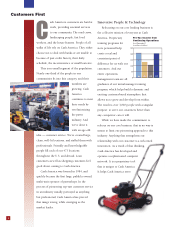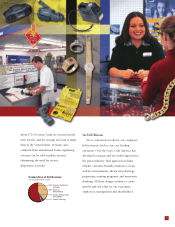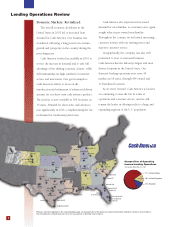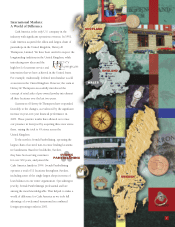Cash America 2001 Annual Report Download - page 15
Download and view the complete annual report
Please find page 15 of the 2001 Cash America annual report below. You can navigate through the pages in the report by either clicking on the pages listed below, or by using the keyword search tool below to find specific information within the annual report.
13
Management’s Discussion and Analysis of Results of Operations and Financial Condition
during 2000. A lower average pawn loan balance during the year, improved
operating performance in the United Kingdom, and the receipt of insurance pro-
ceeds in late 2000 from claims resulting from tornado damage to the corporate
headquarters in March 2000 were factors contributing to the lower debt balance.
Other Items. Effective January 1, 2001, the Company implemented SFAS No.
133 “Accounting for Derivative Instruments and Hedging Activities” and its cor-
responding amendments under SFAS No. 138. The adjustments to fair values of
interest rate cap agreements during 2001 resulted in a loss of $.6 million that is
recorded in “Loss from derivative valuation fluctuations” in the Company’s
Consolidated Statements of Operations in 2001. See Note 6 of Notes to
Consolidated Financial Statements. In prior years, the amortization of the cost of
interest rate cap agreements was included in interest expense.
During 2000, the Company recorded a $9.7 million gain from the settlement
of the insurance claim resulting from the severe damage to its corporate headquar-
ters in Fort Worth, Texas by a tornado in March 2000. Income tax expense of
$3.4 million related to the gain is included in the provision for income taxes.
In 2000, the Company’s share of innoVentry’s net losses was $15.6 million
and the Company’s gain resulting from innoVentry’s issuance of its own stock was
$.1 million. No additional gains or losses have been recorded since June 30,
2000. The Company has accounted for its 19.3% voting interest in innoVentry
by the cost method since February 2001. innoVentry ceased business operations
in September 2001 due to its inability to raise additional financing. Since the
Company’s investment in and advances to innoVentry were written down to zero
in 2000, innoVentry’s decision to cease operations had no effect on the company’s
consolidated financial position or results of operations. See Note 4 of Notes to
Consolidated Financial Statements.
Income Taxes. The Company’s effective tax rate for 2001 was 37.7%. The
Company’s consolidated effective tax rate was impacted in 2000 by the effect of
the valuation allowance provided for the deferred tax assets arising from the
Company’s equity in the losses of innoVentry. Including the effect of the valua-
tion allowance provided, the Company recognized no net deferred tax benefits in
2000 from its equity in the losses of innoVentry. Excluding the effects of the
items related to the Company’s investment in innoVentry and their related tax
effects, the Company’s consolidated effective tax rate was 38.3% for 2000.
Income from Continuing Operations. Diluted income from continuing
operations per share was $.51 for 2001, compared to $.03 for 2000. Excluding
various non-operating unusual items, adjusted diluted income from continuing
operations per share increased to $.52 for 2001 from $.38 for 2000.
Supplemental information regarding the effects of the unusual items is as
follows (in millions, except per share data):
2001 2000
Income from continuing operations before income taxes $20.4 $ 10.8
Less unusual items —
Loss from derivative valuation fluctuations 0.6 —
Gain from disposal of assets —(9.7)
Equity in loss of unconsolidated subsidiary —15.6
Gain from issuance of subsidiary’s stock —(0.1)
Income from continuing operations before
unusual items and income taxes $21.0 $ 16.6
Income from continuing operations after tax
excluding unusual items $13.1 $ 9.9
Income from continuing operations after tax
excluding unusual items per share – Diluted $ 0.52 $ 0.38
Year Ended 2000 Compared to Year Ended 1999
Consolidated Net Revenue. Consolidated net revenue decreased 4.1%, or
$8.3 million, to $195.0 million during 2000 from $203.3 million during 1999.
The following table sets forth 2000 and 1999 net revenue results by operating
segment ($ in millions):
2000 1999 Increase (decrease)
Domestic lending $ 167.6 $ 172.2 $ (4.6) (2.7)%
Foreign lending 24.2 27.4 (3.2) (11.7)%
Total lending 191.8 199.6 (7.8) (4.0)%
Check cashing 3.2 3.7 (0.5) (13.5)%
Consolidated $ 195.0 $ 203.3 $ (8.3) (4.1)%
Weakened domestic loan demand and a lower United Kingdom loan yield
contributed to the lower net revenue. The United Kingdom loan yield was
impacted by the combination of lower redemption rates and lower returns on the
disposition of unredeemed collateral at auction.
The components of net revenue are finance and service charges from pawn
loans, which decreased $8.4 million; net revenue from the disposition of mer-
chandise, which declined $.5 million; other domestic lending fees and franchise
royalties, which increased $1.1 million; and check cashing fees and royalties,
which decreased $.5 million.
Finance and Service Charges. The following is a summary of finance and
service charges related to pawn loans by operating segment for 2000 and 1999
($ in millions):
2000 1999 Increase (decrease)
Domestic lending $ 92.0 $ 97.5 $ (5.5) (5.6)%
Foreign lending 22.7 25.6 (2.9) (11.3)%
Total $114.7 $ 123.1 $ (8.4) (6.8)%
The following table identifies the impact of underlying factors on the total
change in finance and service charges ($ in millions):
Average Total Before
Balance Loan Foreign Foreign
Outstanding Yield Translation Translation Total
Domestic lending $ (6.3) $ 0.8 $ (5.5) $ — $ (5.5)
Foreign lending 0.7 (1.8) (1.1) (1.8) (2.9)
Total $ (5.6) $ (1.0) $ (6.6) $ (1.8) $ (8.4)
During 2000, the company-wide average balance of pawn loans outstand-
ing was 5.9% lower than during 1999. Lower average balances outstanding tend
to result in lower amounts of finance and service charges. Excluding the negative
effects of foreign currency translation adjustments, the company-wide average
balance of pawn loans outstanding was 3.0% lower in 2000 than during 1999. A
6.4% decline in the average balance of domestic pawn loans outstanding caused
the decrease in domestic finance and service charges. The domestic decline was
driven by a 5.6% reduction in the average number of pawn loans outstanding
during 2000, coupled with a .9% decline in the average amount per loan.
Management believes the weakened demand for pawn loans, that became evident
during the second quarter of 1999, may have been partly attributable to the sus-
tained strength in the United States economy that continued throughout most of
2000. However, the average number of domestic pawn loans outstanding during
the fourth quarter of 2000 was only down 2.9% compared to the fourth quarter
of 1999, leading management to believe that the weakness in pawn loan demand
was dissipating. Excluding the negative effects of foreign currency translation
























